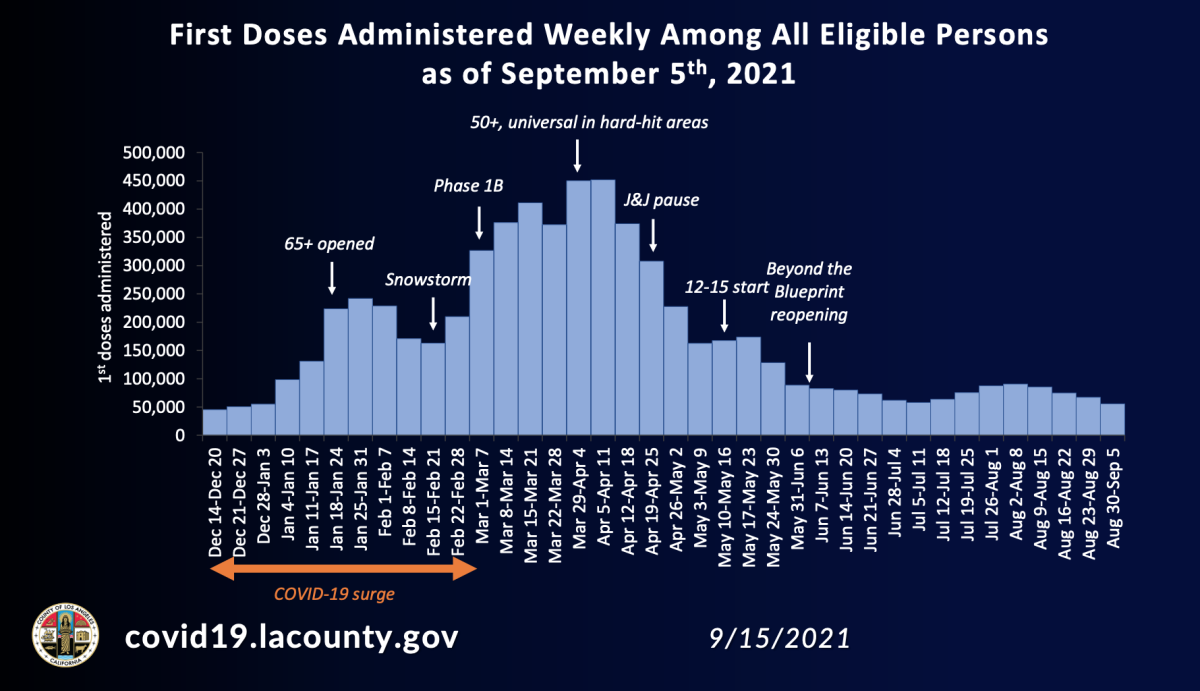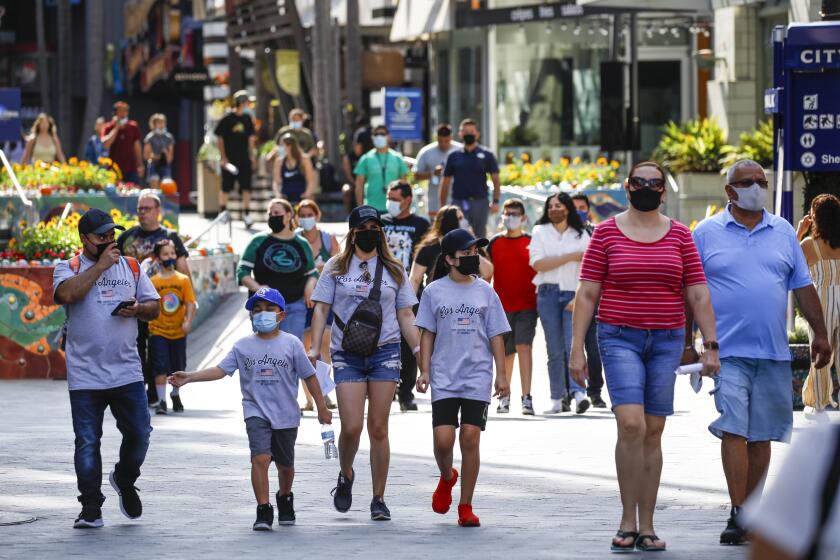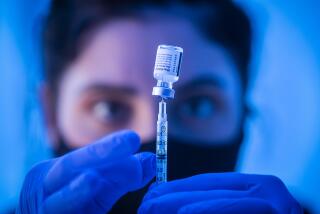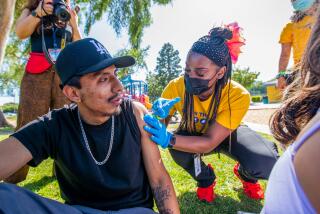L.A. County wants to end COVID-19 surges. That means getting more people vaccinated

- Share via
The pace of COVID-19 vaccinations in Los Angeles County is so slow that there’s a risk of a “cycle of repeated surges every few months,” Los Angeles County’s public health director warns.
There was an increase in vaccinations in late July and early August as the effects of the Delta surge became apparent, but that boost in weekly vaccinations has started to fade, according to data from the county Department of Public Health.
“In order to avoid a cycle of repeated surges every few months, we’ll need to see a significant increase in vaccination coverage,” Public Health Director Barbara Ferrer said as she introduced a forthcoming health order to require proof of vaccination for customers at indoor bars, wineries, breweries, nightclubs and lounges countywide.

In Los Angeles County, 75.7% of residents 12 and older have received at least one dose of vaccine, while 66.9% of residents of all ages have received at least one shot and 59.3% are fully vaccinated.
Dr. George Rutherford, a UC San Francisco epidemiologist and infectious disease expert, has estimated that a community would need to have about 84% of the population vaccinated against COVID-19 to reach “herd immunity,” which occurs when enough people have immunity to interrupt sustained transmission of the disease. Immunity can be obtained not only through vaccination, but also by surviving an infection.
“It’s going to take some substantial amounts of pediatric vaccination to get there,” Rutherford said at a recent campus forum.
The fact that the Delta variant is so much more infectious than earlier strains means it “is going to require more people getting vaccinated” to reach herd immunity, Ferrer recently told the Board of Supervisors.
Even though L.A. County has reported recent reductions in weekly coronavirus cases and hospitalizations, the fact that California has endured four surges demonstrates “there’s a cyclical nature to this virus. And as long as we have large numbers of unvaccinated people here in the county, we’re at the mercy of the cyclical nature” of the pandemic, Ferrer said.
“We doom ourselves, in some ways, to potentially another surge later in October and November, December, when conditions really favor COVID-19 virus replication, if we’re not really diligent now and take some actions now that reduce risk of exposure,” she said. “If more people are vaccinated, we have a lot less transmission.”
The panel approves a COVID booster shot plan for high-risk Americans after rejecting a more sweeping proposal.
A recent USC model suggested that if everyone in L.A. County had been vaccinated this summer, instead of the more than 900 deaths recorded between June 1 and Sept. 1, the county would have reported 80 deaths instead. By contrast, if no one were vaccinated, the model suggested that 13,000 deaths would have occurred in that time.
The data continue “to illustrate to all of us how important it is for us to get our vaccination coverage rates up,” Ferrer said.
Vaccination provides significant protection against infection, hospitalization and death. Of the hundreds of people admitted to L.A. County’s public hospital system since June 15 for a diagnosis primarily linked to COVID-19, 93% have been unvaccinated.
But the ongoing surge also has threatened fully vaccinated people, including those with weak immune systems who, even if inoculated, do not produce a strong immune response to a coronavirus infection.
L.A. County’s public hospital system recently reported its first death of a patient who had been fully vaccinated. The patient was 67 and was on medications that suppressed the immune system due to a serious underlying medical condition.
“I would also ask for everyone who remains unvaccinated to recognize the part that their decision plays in maintaining circulation of the virus among our communities and putting patients such as this at risk,” said Dr. Christina Ghaly, L.A. County’s director of health services.
Health experts have suggested vaccine requirements to enter public settings or as a condition of employment be implemented in order to move the U.S. past the worst pandemic the globe has seen in a century.
Under a new L.A. County health order set to be issued this week, such verification will be necessary for attendees of large theme parks and outdoor “mega events” — those with 10,000-plus attendees — starting Oct. 7.
San Francisco and Berkeley require customers 12 and older in indoor restaurants, bars and gyms to show proof of a COVID-19 vaccination. Contra Costa County, the Bay Area’s third-most populous, has ordered customers of those businesses to show either proof of vaccination or a recent negative coronavirus test result. Palm Springs and neighboring Cathedral City have ordered patrons 12 and older to provide proof of COVID-19 vaccination or a recent negative coronavirus test to enter indoor restaurants and bars.
West Hollywood on Oct. 11 will require patrons 18 and older to show proof they are fully vaccinated to enter indoor restaurants, bars, clubs, theaters and gyms, as well as personal care establishments, including barbershops, nail salons and tanning services.
New York City requires people 12 and older to show they have received at least one dose of vaccine to enter indoor restaurants, bars, nightclubs, coffee shops, gyms, movie theaters, museums, sports arenas, convention centers and bowling alleys.
In Hawaii, a number of hotels and resorts will begin requiring customers to show proof of full vaccination to enter and will not allow unvaccinated people in, even if they have proof of a recent negative test, the Associated Press reported. Honolulu and the entire island of Oahu this week began requiring proof of vaccination or a recent negative coronavirus test, conducted in the last 48 hours, to enter restaurants, bars, indoor gyms, and entertainment and recreational settings.
State Sen. Josh Newman (D-Fullerton) said at a recent news conference that it will be important to increase the social cost of remaining unvaccinated. Newman recently recounted his conversation with the manager of a grocery distribution center who struggled to encourage some of his employees to get vaccinated.
Then, in a surprise, one of the holdouts did get vaccinated. The reason? The worker’s wife wanted to go to Hawaii, and the couple had to get a shot to get into the hotel.
“The level of social cohesion that’s necessary to get to something like herd immunity has just been really challenging. So we have to do everything we can to get there,” Newman said.
It will be especially important for people to get vaccinated for the flu this fall, in addition to making sure they are fully vaccinated for COVID-19, health officials said. Experts fear a “twindemic” of flu and COVID-19 this fall and winter, a risk that’s higher if too few people get their flu and COVID-19 vaccinations.
“Give your nurses and doctors and healthcare system a break — get your vaccinations,” said Bruce Barton, director of emergency management for Riverside County. Large swaths of California are suffering from a nursing shortage, and higher rates of flu and COVID-19 vaccinations will relieve the potential strain on hospitals later in the fall.
“If I’m concerned about any one thing the most when it comes to our healthcare system, it is that staffing,” Barton said.
More to Read
Sign up for Essential California
The most important California stories and recommendations in your inbox every morning.
You may occasionally receive promotional content from the Los Angeles Times.

















